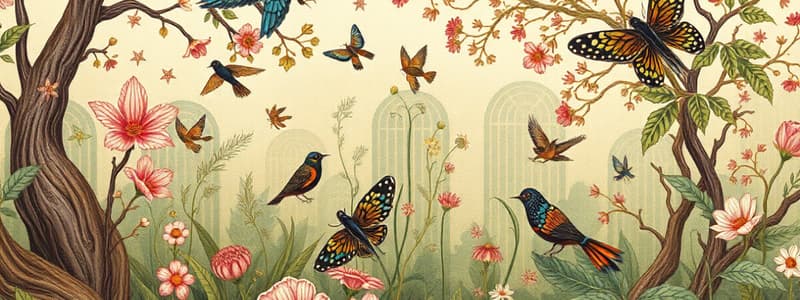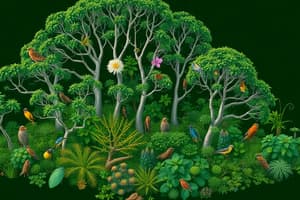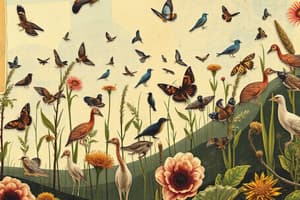Podcast
Questions and Answers
Two forest communities each contain 100 individual trees divided among four species (A, B, C, and D). Community 1 has an even distribution (25 each), while Community 2 is dominated by species A (80A, 5B, 5C, 10D). How would an ecologist likely compare the two communities?
Two forest communities each contain 100 individual trees divided among four species (A, B, C, and D). Community 1 has an even distribution (25 each), while Community 2 is dominated by species A (80A, 5B, 5C, 10D). How would an ecologist likely compare the two communities?
- Community 2 has greater species richness, making it more diverse than Community 1.
- Community 1 and 2 exhibit equivalent species richness, but Community 1 is more diverse. (correct)
- Community 2 has greater species richness, but Community 1 is more stable.
- Community 1 has greater species richness, making it more diverse than Community 2.
Researchers establish several experimental grassland plots with varying numbers of perennial plant species (1, 2, 4, 8, or 16). After ten years, they measure the biomass produced in each plot. What outcome would support the hypothesis that higher diversity enhances community productivity?
Researchers establish several experimental grassland plots with varying numbers of perennial plant species (1, 2, 4, 8, or 16). After ten years, they measure the biomass produced in each plot. What outcome would support the hypothesis that higher diversity enhances community productivity?
- Plots with 16 species produced the most consistent and highest amounts of biomass. (correct)
- Single-species plots produced the most biomass due to resource specialization.
- All plots produced similar amounts of biomass regardless of species number.
- Plots with 2-4 species produced the most biomass due to optimal competition balance.
Several communities have different compositions of plant species. Which community would likely exhibit the greatest resilience to a prolonged drought?
Several communities have different compositions of plant species. Which community would likely exhibit the greatest resilience to a prolonged drought?
- A community dominated by a single species adapted to wet conditions.
- A community with moderate species richness and strong competitive exclusion.
- A community with low species richness and a few dominant species.
- A community with high species richness and even species abundance. (correct)
Considering the concept of community stability, which scenario would best represent a community with high stability?
Considering the concept of community stability, which scenario would best represent a community with high stability?
Why might a more diverse community be more resistant to the establishment of introduced (non-native) species?
Why might a more diverse community be more resistant to the establishment of introduced (non-native) species?
What is the difference between species richness and relative abundance in the context of community ecology?
What is the difference between species richness and relative abundance in the context of community ecology?
Imagine two communities. Community X has 5 species with very similar resource needs. Community Y has 5 species, each with highly distinct resource needs. All other factors being equal, which community is likely to be more productive, and why?
Imagine two communities. Community X has 5 species with very similar resource needs. Community Y has 5 species, each with highly distinct resource needs. All other factors being equal, which community is likely to be more productive, and why?
A researcher observes that a particular plant community has high species richness but is dominated by a single species that outcompetes all others for sunlight. How would you characterize this community's diversity?
A researcher observes that a particular plant community has high species richness but is dominated by a single species that outcompetes all others for sunlight. How would you characterize this community's diversity?
In artificial tree hole experiments, what prediction of the energetic hypothesis was supported?
In artificial tree hole experiments, what prediction of the energetic hypothesis was supported?
Why can't large carnivores typically subsist solely on very small food items?
Why can't large carnivores typically subsist solely on very small food items?
How do foundation species primarily impact their communities?
How do foundation species primarily impact their communities?
What was the primary consequence of the introduction of chestnut blight to eastern North American forests?
What was the primary consequence of the introduction of chestnut blight to eastern North American forests?
What distinguishes a keystone species from a foundation species?
What distinguishes a keystone species from a foundation species?
How might the removal of a keystone predator from a community most likely affect the community's structure?
How might the removal of a keystone predator from a community most likely affect the community's structure?
What trophic level do trees belong in an ecosystem?
What trophic level do trees belong in an ecosystem?
What is an example of an exception to the limitations of large carnivores feeding on small organisms?
What is an example of an exception to the limitations of large carnivores feeding on small organisms?
What is the role of microorganisms and insects in tree holes?
What is the role of microorganisms and insects in tree holes?
How could the introduction of an invasive insect species that targets a foundation plant species affect a community?
How could the introduction of an invasive insect species that targets a foundation plant species affect a community?
In the Connecticut study, what conclusion did the scientists draw regarding the relationship between community diversity and the survival of an introduced tunicate species?
In the Connecticut study, what conclusion did the scientists draw regarding the relationship between community diversity and the survival of an introduced tunicate species?
What is the critical role of decomposers in a trophic structure?
What is the critical role of decomposers in a trophic structure?
If the abundance of carnivores that consume zooplankton significantly increased, which of the following would most likely occur based on the trophic relationships in a typical marine ecosystem?
If the abundance of carnivores that consume zooplankton significantly increased, which of the following would most likely occur based on the trophic relationships in a typical marine ecosystem?
In an Antarctic pelagic community, how do squids function within the food web??
In an Antarctic pelagic community, how do squids function within the food web??
What is a primary difference between a food chain and a food web?
What is a primary difference between a food chain and a food web?
How can ecologists simplify complicated food webs for easier study?
How can ecologists simplify complicated food webs for easier study?
What is the energetic hypothesis regarding food chain length?
What is the energetic hypothesis regarding food chain length?
According to the energetic hypothesis, in which type of habitat would you expect to find relatively longer food chains?
According to the energetic hypothesis, in which type of habitat would you expect to find relatively longer food chains?
Approximately what percentage of energy stored in the organic matter of each trophic level is converted to organic matter at the next trophic level?
Approximately what percentage of energy stored in the organic matter of each trophic level is converted to organic matter at the next trophic level?
How might an introduced species affect a community's trophic structure?
How might an introduced species affect a community's trophic structure?
What term describes an organism's position in a food chain or food web?
What term describes an organism's position in a food chain or food web?
If a primary consumer feeds on 500 J of plant material, how much energy is expected to be converted into secondary consumer biomass, assuming the average energy transfer efficiency?
If a primary consumer feeds on 500 J of plant material, how much energy is expected to be converted into secondary consumer biomass, assuming the average energy transfer efficiency?
Which of the following scenarios best illustrates the concept of a 'nonexclusive' consumer within a food web?
Which of the following scenarios best illustrates the concept of a 'nonexclusive' consumer within a food web?
How do humans impact the Antarctic marine food web?
How do humans impact the Antarctic marine food web?
Which of the following is an example of a primary producer?
Which of the following is an example of a primary producer?
Flashcards
Species Diversity
Species Diversity
The variety of different kinds of organisms in a community.
Species Richness
Species Richness
The number of different species in a community.
Relative Abundance
Relative Abundance
The proportion each species represents of all individuals in the community.
Community Stability
Community Stability
Signup and view all the flashcards
Higher-Diversity Communities
Higher-Diversity Communities
Signup and view all the flashcards
Biomass
Biomass
Signup and view all the flashcards
Introduced Species
Introduced Species
Signup and view all the flashcards
Cedar Creek Ecosystem Science Reserve
Cedar Creek Ecosystem Science Reserve
Signup and view all the flashcards
Diversity in Communities
Diversity in Communities
Signup and view all the flashcards
Trophic Structure
Trophic Structure
Signup and view all the flashcards
Food Chain
Food Chain
Signup and view all the flashcards
Trophic Level
Trophic Level
Signup and view all the flashcards
Decomposers
Decomposers
Signup and view all the flashcards
Food Web
Food Web
Signup and view all the flashcards
Phytoplankton
Phytoplankton
Signup and view all the flashcards
Zooplankton
Zooplankton
Signup and view all the flashcards
Carnivores
Carnivores
Signup and view all the flashcards
Omnivores
Omnivores
Signup and view all the flashcards
Energetic Hypothesis
Energetic Hypothesis
Signup and view all the flashcards
Food Chain Length
Food Chain Length
Signup and view all the flashcards
Primary Producers
Primary Producers
Signup and view all the flashcards
Functional Groups
Functional Groups
Signup and view all the flashcards
Tree Holes
Tree Holes
Signup and view all the flashcards
Foundation Species
Foundation Species
Signup and view all the flashcards
Keystone Species
Keystone Species
Signup and view all the flashcards
Trophic Interactions
Trophic Interactions
Signup and view all the flashcards
Carnivore Size Limitations
Carnivore Size Limitations
Signup and view all the flashcards
American Chestnut Impact
American Chestnut Impact
Signup and view all the flashcards
Predatory Insects
Predatory Insects
Signup and view all the flashcards
Leaf Litter's Role
Leaf Litter's Role
Signup and view all the flashcards
Study Notes
Species Diversity
- Species diversity measures the variety of species and their relative abundance within a community.
- Species richness is the count of different species.
- Relative abundance is the proportion of each species' individuals in the community.
- Higher-diversity communities are more productive and resilient to environmental stress.
- Diverse communities are better able to resist the establishment of introduced species.
Diversity and Community Stability
- Experiments manipulate biodiversity to show its impact.
- Higher-diversity communities are more stable year-to-year in their productivity.
- Higher-diversity communities often withstand and recover better from environmental stressors.
- Diverse communities often outcompete introduced species for resources.
Trophic Structure
- Trophic structure describes the feeding relationships between organisms.
- A food chain traces energy transfer from producers to consumers and decomposers.
- Trophic levels are the positions in a food chain.
- Food webs intertwine multiple food chains.
Food Webs
- Food webs connect species based on who eats whom.
- Species may occupy multiple trophic levels in a food web.
- Food webs can be simplified by grouping species with similar trophic roles or isolating sections less interconnected.
Limits on Food Chain Length
- Food chains are typically short.
- The energetic hypothesis explains this, stating that energy transfer is inefficient (only ~10% of energy is transferred).
- Habitats with higher photosynthetic production usually support longer food chains.
- Carnivore size constrains the size of prey they can consume.
- Baleen whales are an exception due to their adaptations for consuming large quantities of small organisms.
Species with a Large Impact
- Certain species significantly impact community structure, often through trophic interactions or environmental effects.
- Foundation species are large or abundant, they provide habitat/food & are often competitively dominant (e.g., trees, shrubs, marine algae).
- Keystone species are vital but not usually abundant, their roles affect community structure. (e.g., a sea star controlling mussel populations).
- Removing a foundation species can have major impacts on other species within the community.
Studying That Suits You
Use AI to generate personalized quizzes and flashcards to suit your learning preferences.




